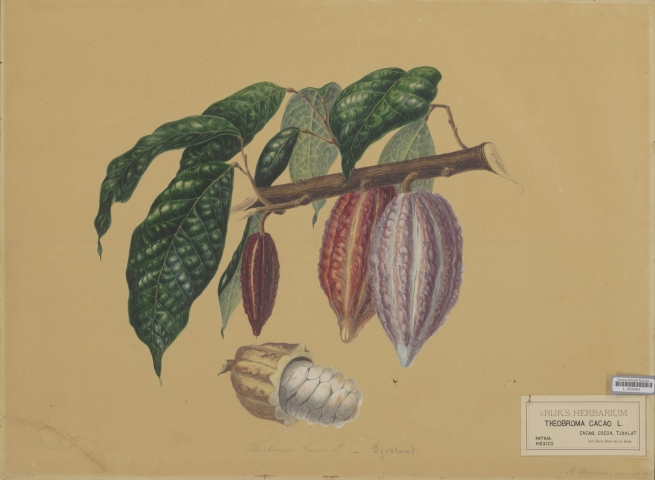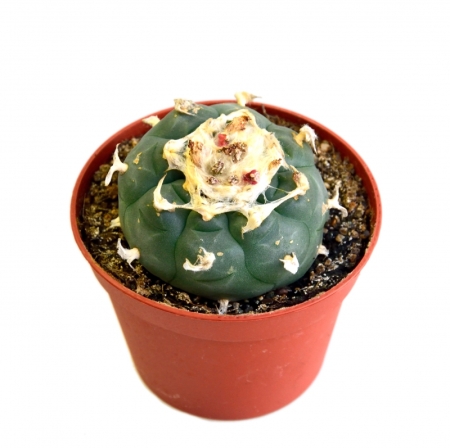6 beginner mistakes when taking care of the mescaline cactus peyote
I have become so attached to my own peyotes, that I might not have the heart to harvest them one day... But tips on how to care for them as well as possible I certainly have, whether you're doing this because you love them, or because you want to get them big and round, for a psychedelic experience. In this blog, I'll help you get started on taking care of your own peyote cactus with a realistic view. We will discuss 6 common beginner mistakes in taking care of this spineless specimen.
Peyote is a psychedelic cactus that captures the imagination. When the Western world first came in contact with the realm of psychedelics in the 1950s, it was mescaline that first introduced them to it. Even before psilocybin, DMT or any other entheogen.
In literature you can find countless books in which the inspiration is largely due to a trip with mescaline. Look at Aldous Huxley for example, who describes the use of this psychedelic in his famous work The Doors Of Perception. I can tell you that it is truly an honor to be able to take care of a peyote. If you want to handle it successfully, keep in mind a few factors.
Are you a caring parent?
When I was eighteen and just leaving home, I still had a lot to learn about responsibility. Of course, you can't expect to create a beautiful collection of houseplants without a lot of effort and especially attention. My dorm room looked pathetic with a withered succulent and a collection of spriggy herbs. I barely gave them a second glance and had my head in the clouds with other things, like my school marks. Every now and then, while riding my bike, I would feel guilty because I had forgotten to water them again. A few moments later my attention was already focused on something else in my busy life.
"Taking care of a cactus is not that difficult, is it?"
You often hear that people who get a plant for the first time, choose a cactus, because it requires almost no effort. A cactus needs hardly any water and little attention, you would think. Yet cacti often die, because people have no idea that this prickly friend does have certain requirements.


When you’ve gathered enough information after reading this blog and you feel ready, run to Sirius to buy your own mescaline cactus and pamper it!
The legend of the Vision Quest
Where does the use of the peyote cactus actually come from? Originally, this entheogenic cactus was used by indigenous peoples of North America and Mexico as a spiritual medicine. Archaeological research indicates that the use may be more than 5,700 years old. The origins of "peyotism" remain a mystery.
Legend has it that a man or woman once got lost in the desert. This person was perishing from hunger and thirst and the sun was burning so fiercely the end seemed near. Then suddenly a voice of a spirit said:
"Take this plant and you will satisfy your hunger and thirst and find your way back home." Within reach grew the peyote, in which was found the wisdom to be able to return home.
To this day, this scene is recreated in the form of a so-called "vision quest," where one meditates without water or food for a few days and then consumes peyote (if necessary).
The Native American Church (NAV) has more than 250,000 members worldwide. This religion largely revolves around peyote. The cultivation and consumption of peyote, as well as its psychedelic ingredient mescaline, is prohibited and is on the Schedule 1 list in the U.S. An exception has been made for the NAC and they are legally allowed to use peyote during rituals.
The birthplace of peyote
Originally, peyote is found in the deserts of northern Mexico and the southwestern United States. Normally they grow in groups of three to more than fifty, usually somewhat hidden near bushes.
Peyotes grow very slowly and can take up to 20 years to mature and flower.
Even for a home-grown cactus, it is important to realize that you must give it a long time (perhaps years) to grow.
However, the process can be sped up a bit with the right location, enough sun and watering at the right times.
Beginners' mistakes when growing a peyote cactus:
1. Watering your Peyote cactus too much or not enough
There are a number of ambiguities about watering a cactus. Perhaps when a cactus is mentioned, the association is quickly made with a Lucky Luke scene, where a cork-dry desert is the habitat of a lush cactus. Well, this is not entirely incorrect. The peyote cactus (Lophophora williamsii) loves heat and can survive long periods without water. It is native to the Chihuahuan Desert, located on the border of the United States (Texas) and Mexico.
Water your cactus regularly during the summer, especially when the weather is warm and it is in a sunny, well-ventilated place. Depending on the temperature, you can give it more or less water. In spring (from mid-March) you may water your peyote for the first time. Do this only on days when the sun is shining. If your cactus has wet feet for too long, it will soon be susceptible to root rot. Make sure that there is enough time between the watering periods to allow the soil to dry out completely.
Note: only pour water on the soil mix, never on the peyote itself.
In the winter period (mid October to mid March) your peyote doesn't need any water at all. Put it inside, where it gets enough daylight, in a room where it stays between 5 and 10 degrees Celsius.
2. Using the wrong soil mix for your cactus
When you buy your cactus, it comes in a pot with soil. Of course you can go to a garden center to buy more cactus soil. However, several professional growers warn against poor quality. Basically, it's best to make your own mix.
There are several recipes available where you can vary and work with ingredients that are most readily available. It is very important that your mix has good water permeability. As mentioned earlier, a cactus is quickly prone to root rot if it stays moist for too long. Well draining soil means: when you pour water it should be gone within seconds.
Below is a very simple recipe that any hobby grower can cobble together. Soil, sand and gravel are available for free, perlite (rock) is best bought in a garden center.
Recipe for your own peyote soil mix:
- 20% biological (garden) soil
- 30% gravel
- 40% sand
- 10% perlite (available in a garden center)
3. Too much nutrition/fertilizer
A cactus feeds on minerals and trace elements which are released very slowly from rocks. Never place a cactus in a nutrient rich soil with fertilizer, this is far too rich and this can cause it to crack. To make your peyote grow faster you can fertilize it up to twice a year.
In the spring you can water your cactus with some extra nutrition. Always use only half of the recommended dosage!
4. Too much sunlight, or too little
Yes, it loves the sun and you are well advised to put it outside a lot in the spring and summer. But beware: the cactus has to get used to it first, especially when it has been inside for long periods of time, for example during the winter. Even if you have just bought it, it is better not to expose it directly to the burning sun as this can damage it. First put it in a shady spot for a week. After this you can put it in a sunny place for a few hours a day and extend this period more and more.
As soon as it is used to sunlight, you can put it in full sunlight as much as possible, preferably outside. If you can only put it inside, put it in the sunniest place (south).
It is also possible that your cactus is getting too much direct sunlight. It will tell you this by turning red, a sign that it is burning. In this case, put it in a different place so it can recover.
Of course, putting your peyote outside only applies to the spring and summer period! In the winter period (mid-October to mid-March) it stays inside.
5. Harvesting your peyote cactus too soon
Chances are you take a peyote because you want to harvest and consume it sooner or later. Like the San Pedro, among others, it contains a number of powerful alkaloids, including mescaline. A trip from peyote is highly regarded and many a psychonaut is eagerly seeking for this experience. But, as with many things in life: being patient is rewarded. When you give your cactus the time and attention it needs, you get an entheogenic experience in return.
The peyote grows extremely slowly and this does not go well with an impatient psychonaut. If you really can't wait, you'd better choose the San Pedro cactus. This fast-growing and prickly mescaline cactus grows rapidly and, depending on its size, can be harvested within a year.
Is this still too slow? Well, if you're planning on tripping this weekend, opt for Sirius' Magic Truffles, packed per serving in handy boxes and ready to use right away.
6. Tap water instead of rainwater
A mistake many growers make: what do you give your peyote to drink? Tap water is not suitable because it is too hard and does not contain the minerals necessary for development. It is best to give your cactus (and your other house plants preferably too) rainwater. It can be a fun project to build your own rainwater cistern if you don't have two left hands. Simply, you can do it with a large barrel that the downspout connects to. Rainwater gathering is all the rage and a must as a green lover, if you ask me.
Sirius customer service answers all your cactus questions!
If you get all prickly from this bombardment of information, you can contact the customer service of Sirius. They can help you immediately, so you can confidently become the proud caretaker of your own peyote cactus.
Blog photo: Hugo Simberg - Garden of Death
Did you enjoy reading this article and do you like to write yourself? We are always looking for people who share our passion for natural products, who can also translate this into great texts. And we have an interesting reward for this. View all information for writers.
 Blog Magic Mushrooms
Mushroom Grow Kit Manual
Are you a beginner or do you have some experience growing mushrooms? There are ways you can get the biggest harvests. These tips will make growing Mag [..]
06-12-2020
9 minutes
Blog Magic Mushrooms
Mushroom Grow Kit Manual
Are you a beginner or do you have some experience growing mushrooms? There are ways you can get the biggest harvests. These tips will make growing Mag [..]
06-12-2020
9 minutes
 Blog User Reports
Musical journey with Golden Teacher
For many psychonauts, music is an important aspect during a psychedelic experience. Tones seem to float right through you, you feel emotions of the si [..]
24-02-2021
6 minutes
Blog User Reports
Musical journey with Golden Teacher
For many psychonauts, music is an important aspect during a psychedelic experience. Tones seem to float right through you, you feel emotions of the si [..]
24-02-2021
6 minutes
 Blog User Reports
User Report: Bionix Cocoa Power
For this trip report, I share my experience with a natural smartdrug based on a pure cocoa extract, supplemented with plant extracts of bitter orange, [..]
Blog User Reports
User Report: Bionix Cocoa Power
For this trip report, I share my experience with a natural smartdrug based on a pure cocoa extract, supplemented with plant extracts of bitter orange, [..]














 Nederlands
Nederlands Italiano
Italiano Deutsch
Deutsch Français
Français Português
Português Español
Español Polski
Polski